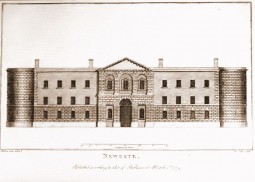
There was a square tower located between Newgate and Gormond’s Gate, described as being four stories high, sixteen feet square and three feet thick. This tower belonged to a Richard Browne in the 17th century and was known as “Browne’s Castle”. Subsequently, it was converted into an inn known as the “Black Dog”, because of a sign with the image of a hound, suspended outside. In the early part of the 18th century, the Black Dog changed its use again and became Marshalsea prison.
In 1634, the House of Commons ordered that a donation of two shillings from every member, be given for the upkeep of the poor prisoners in Dublin gaols. The ninety two prisoners who were incarcerated in Newgate Prison sent a petition to the Barons of the Exchequer, stating they were not receiving anything but the charity of the people of the city who passed the prison gates. Because of the large amount of prisoners, this charity was totally inadequate and they said that they would perish unless adequate funding was provided.
Oliver Plunkett, Catholic Primate of all Ireland, was committed to Newgate Prison in 1679 and remained there until he was sent to London in October 1680, where he was subsequently executed.
According to grants of Henry V, Richard 111 and Edward V1, the Mayor, Bailiffs and Recorder of Dublin and their successors, were constituted Justices of the Peace with special powers pertaining to this office. Charles 1 extended this position to six senior Aldermen of the city and other members of the Corporation. These individuals left the management of their office entirely to clerks, who paid their employees a percentage of all fees they received, thus this system was open to dishonesty and abuse. The clerks were in league with the constables, who were of a low grade, and continually arrested citizens on very flimsy pretext. These unfortunate victims were incarcerated in the Black Dog until they could pay the fees demanded of them. While they were awaiting bail, the corrupt constables tried to extort money from them by every means possible.
In both Newgate and the Black Dog, the gaolers carried on the business of selling liquor to the inmates on entering the Black Dog, even for only one night, the prisoner had to pay two shillings and two pence for a “penny pot”. If the prisoner refused to pay, he was stripped and violently beaten. Prisoners who did not have enough money had their clothes confiscated and sold, to make up the shortfall. There were twelve rooms in the Black Dog, for the reception of prisoners. Two of these rooms had five beds each, but the others were no better than closets and could only hold one bed. The general rent for lodgings in these rooms was one shilling per night for each man, but sometimes much higher prices were charged. Frequently, four or five men were put into one bed, but still had to pay the mandatory shilling, which was collected by the gaoler’s wife. Prisoners who could not pay the fee were thrown into a damp, dark dungeon, which was approximately twelve feet square and eight feet high and often 14 to 20 people were thrown into this dismal place.
Prisoners in Newgate prison were frequently held for several days, without being committed. The fee was four pence per night, for not being confined to the felon’s room, and one shilling and four pence was charged for the “penny pot”. In 1729, the number of prisoners in Newgate was one hundred and sixty. In 1750 the prison was improved and altered but in 1767, it was found to be in very poor condition and in a state of decay once again. At this time there were 120 prisoners in a gaol suitable for the accommodation of 70 prisoners. Parliament was informed of these inadequacies but no remedial steps were taken until 1773, when the foundation of a new prison was laid, on the north side of the city. The new prison in Green Street was opened in September 1780. The Black Dog continued for some years. In 1794, a new Sheriff’s Prison in Green Street commenced and the infamous Black Dog was finally abandoned.








